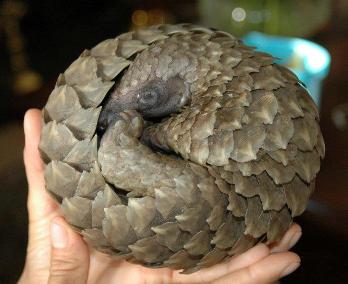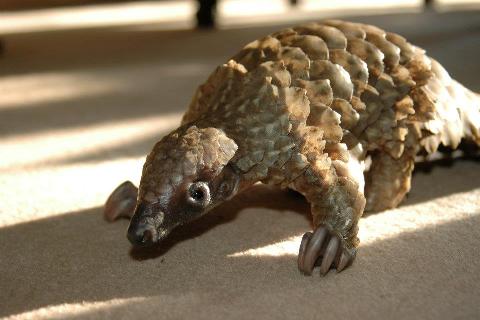Adaptations - Protection Perfected
There are many ways that pangolins have evolved and
adapted over time in order to better survive and prosper in their
habitat and surroundings. The main
adaptation that they have is tough scales that cover their bodies,
protecting them from predators.
These
scales are
moveable and are
actually made up of hairs that have been fused
 together,
making them strong and durable. Because the scales are so dense, they
are also very heavy, making up 20% of the animals' body weight. As
well as being extremely tough, the scales are very sharp and pangolins are
able to swing their long tails around, using them as a jagged club.
These hard pieces of keratin even protect against desiccation, or water
loss, and their brown color helps pangolins blend in with the various
environments in which they live. With the many functions and uses of
the scales of pangolins, it is easy to see how these are the most important
adaptation they possess.
together,
making them strong and durable. Because the scales are so dense, they
are also very heavy, making up 20% of the animals' body weight. As
well as being extremely tough, the scales are very sharp and pangolins are
able to swing their long tails around, using them as a jagged club.
These hard pieces of keratin even protect against desiccation, or water
loss, and their brown color helps pangolins blend in with the various
environments in which they live. With the many functions and uses of
the scales of pangolins, it is easy to see how these are the most important
adaptation they possess.
 Another important adaptation that pangolins possess is
their ability to curl into a ball when they feel threatened or are attacked.
When they do this, only their scales are exposed, making them a very tough
prey item. The muscles in their abdomen are very strong and help keep
the animals curled up even when predators are trying to pry them open.
Without this ability, they would
be very vulnerable because they are slow moving. Without this
essential adaptation, a predator could
easily flip the mammals over, exposing their less-protected belly area.
Another important adaptation that pangolins possess is
their ability to curl into a ball when they feel threatened or are attacked.
When they do this, only their scales are exposed, making them a very tough
prey item. The muscles in their abdomen are very strong and help keep
the animals curled up even when predators are trying to pry them open.
Without this ability, they would
be very vulnerable because they are slow moving. Without this
essential adaptation, a predator could
easily flip the mammals over, exposing their less-protected belly area.
 Because
of the long claws on their front limbs, which make it difficult for these
animals to walk on all four legs, they have adapted a special way of
walking. Pangolins usually walk only on their rear legs, holding their
front legs slightly above the ground and dragging their tail behind them to help with stability and balance. Although they usually
move very slowly, in times of distress they can reach speeds of up to 5
miles per hour. They are also able to move on all four limbs for short
periods of time, curling their front claws and paws so they do not damage
them.
Because
of the long claws on their front limbs, which make it difficult for these
animals to walk on all four legs, they have adapted a special way of
walking. Pangolins usually walk only on their rear legs, holding their
front legs slightly above the ground and dragging their tail behind them to help with stability and balance. Although they usually
move very slowly, in times of distress they can reach speeds of up to 5
miles per hour. They are also able to move on all four limbs for short
periods of time, curling their front claws and paws so they do not damage
them.
Small
eyes with thick eyelids are a final significant adaptation pangolins have. Because
they have a very good sense of smell and decent hearing, using chemoreceptors and mechanoreceptors to detect environmental stimuli, good eyesight is not necessary.  Therefore, pangolins
have small eyes with tough eyelids that protect them from the bites of
insects they are consuming. When the animals get into an insect mound
thousands of insects are crawling around. As pangolins attempt to
consume ants or termites, the insects try to bite
them. If pangolins did not posses thick eyelids, their eyes would be
an easy target for insects to bite, preventing them from feeding effectively.
Therefore, pangolins
have small eyes with tough eyelids that protect them from the bites of
insects they are consuming. When the animals get into an insect mound
thousands of insects are crawling around. As pangolins attempt to
consume ants or termites, the insects try to bite
them. If pangolins did not posses thick eyelids, their eyes would be
an easy target for insects to bite, preventing them from feeding effectively.
Click here to find out what the pangolin eats!
Back to Homepage
